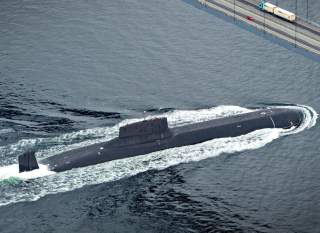100-Megatons of Doom: How Big of a Threat Is Russia's Status-6 "Poseidon" Nuclear Torpedo?
Or just some more fake news?
Key point: Moscow's doomsday weapon may sound scary but it is more stupid and impracticable than anything else.
How do you stop a nuclear-powered torpedo designed to bury enemy cities under a tsunami?
Russia's Status-6 "Poseidon" torpedo has excited the fears -- or the overactive imaginations -- of Russia's enemies. Calling it is a torpedo is a misnomer. While the precise capabilities of the weapon are mysterious, it appears to be about 80 feet long -- which makes it more like a mini-submarine or an underwater ballistic missile. Poseidon is propelled by a nuclear reactor to a speed of 115 miles per hour and operates at deep depths up to 3,300 feet. It is armed with a massive 100-megaton warhead powerful enough to generate a giant tidal wave to destroy coastal cities.
How useful such a weapon would be is debatable. Poseidon is too slow, compared to ICBMs and bombers, to be useful in a first strike or an immediate retaliatory strike. Moving at high speeds may make it so noisy that anti-submarine can detect it, and its autonomous nature brings up all the questions about armed robots (especially ones carrying mega-bombs).
Nonetheless, as a psychological weapon, it's brilliant. There is something frightening, like a Hollywood monster movie, about the thought of a robot tsunami-bomb creeping along the sea floor.
But for every vampire, there is a stake waiting to slay it through the heart. H I Sutton, a naval analyst who runs the Covert Shores blog on naval affairs, offers some ideas on technology that NATO can employ to halt Poseidon.
Sutton assumes that Poseidon's "operating modes and route planning will likely be simple (read reliable) and relatively direct, relying on speed and depth for survival." That being the case, one countermeasure would be to seed the seabed with networks of sensor-mines to detect and destroy Poseidons. "Ideally the sensor networks would include their own effectors (e.g. torpedo armed mines) to minimize the delay from detection to neutralization, since the targets will be moving much faster than traditional submarine targets," Sutton writes.
Sutton also wonders whether Poseidons could be killed by long-range hypersonic glide vehicles launched by U.S. Navy submarines. "The payload could be next-generation lightweight torpedo or nuclear depth charge similar to the retired Subroc [rocket-launched anti-submarine torpedo] weapon," he writes. "The short flight time and long range of this type of system would allow kills far outside realistic ranges for torpedoes and allow submarines operating in the North Atlantic to react to Poseidon launches detected in the Arctic region, hitting the target while it is still reasonably near to the sensor which detected it."
Recommended: What Will the Sixth-Generation Jet Fighter Look Like?
Recommended: Imagine a U.S. Air Force That Never Built the B-52 Bomber
Recommended: Russia's Next Big Military Sale - To Mexico?
Recommended: Would China Really Invade Taiwan?
Stopping weapons like Poseidon will likely require Western navies to develop a new generation of torpedoes. "The current families of US Navy and Royal Navy torpedoes were developed to counter fast deep-diving Russian submarines," writes Sutton. "While they are highly capable, the even greater combination of speed and depth of Poseidon means that new weapons will need to be developed. These are likely to be characterized by increases in range and autonomy, blurring the distinction with Unmanned Underwater Vehicles (UUVs)."
Michael Peck is a contributing writer for the National Interest. He can be found on Twitter and Facebook. This first appeared in September 2018.
Image: Reuters

